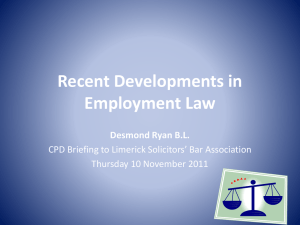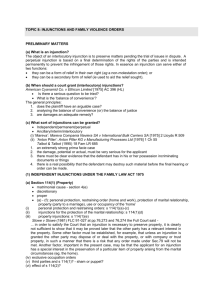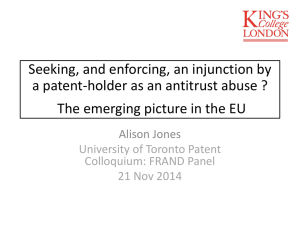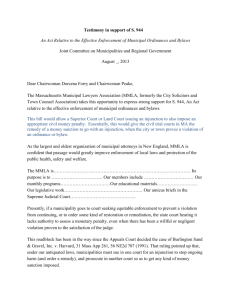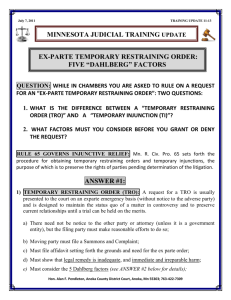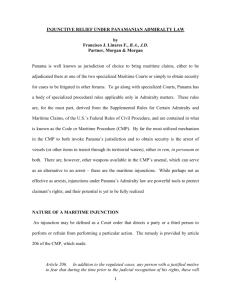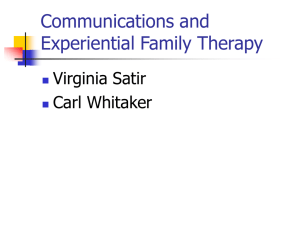Redecision Therapy as a Process of New Belief Acquisition: Survival
advertisement
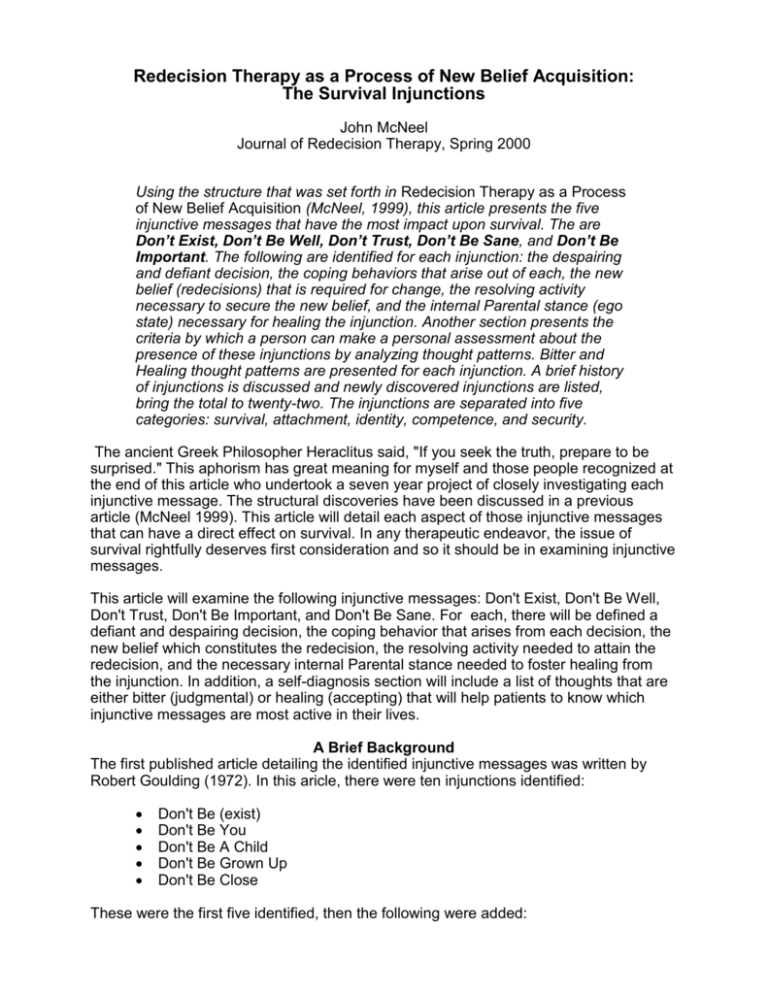
Redecision Therapy as a Process of New Belief Acquisition: The Survival Injunctions John McNeel Journal of Redecision Therapy, Spring 2000 Using the structure that was set forth in Redecision Therapy as a Process of New Belief Acquisition (McNeel, 1999), this article presents the five injunctive messages that have the most impact upon survival. The are Don’t Exist, Don’t Be Well, Don’t Trust, Don’t Be Sane, and Don’t Be Important. The following are identified for each injunction: the despairing and defiant decision, the coping behaviors that arise out of each, the new belief (redecisions) that is required for change, the resolving activity necessary to secure the new belief, and the internal Parental stance (ego state) necessary for healing the injunction. Another section presents the criteria by which a person can make a personal assessment about the presence of these injunctions by analyzing thought patterns. Bitter and Healing thought patterns are presented for each injunction. A brief history of injunctions is discussed and newly discovered injunctions are listed, bring the total to twenty-two. The injunctions are separated into five categories: survival, attachment, identity, competence, and security. The ancient Greek Philosopher Heraclitus said, "If you seek the truth, prepare to be surprised." This aphorism has great meaning for myself and those people recognized at the end of this article who undertook a seven year project of closely investigating each injunctive message. The structural discoveries have been discussed in a previous article (McNeel 1999). This article will detail each aspect of those injunctive messages that can have a direct effect on survival. In any therapeutic endeavor, the issue of survival rightfully deserves first consideration and so it should be in examining injunctive messages. This article will examine the following injunctive messages: Don't Exist, Don't Be Well, Don't Trust, Don't Be Important, and Don't Be Sane. For each, there will be defined a defiant and despairing decision, the coping behavior that arises from each decision, the new belief which constitutes the redecision, the resolving activity needed to attain the redecision, and the necessary internal Parental stance needed to foster healing from the injunction. In addition, a self-diagnosis section will include a list of thoughts that are either bitter (judgmental) or healing (accepting) that will help patients to know which injunctive messages are most active in their lives. A Brief Background The first published article detailing the identified injunctive messages was written by Robert Goulding (1972). In this aricle, there were ten injunctions identified: Don't Be (exist) Don't Be You Don't Be A Child Don't Be Grown Up Don't Be Close These were the first five identified, then the following were added: The Survival Injunctions John McNeel Don't Don't Make It Don't Be Sane (or Well) Don't Be Important Don't Belong In 1976, the Gouldings published an article in response to receiving the Eric Berne Memorial Scientific Award for "Ten Injunctions and Redecisions." By that time they had added two m ore injunctions: Don't Think Don't Feel In the discussion of various injunctions in that article, they also mentioned the concept of Don't Trust, but included it as a phenomenon occurring with the Don't Be Close injunction rather than listing it as a separate injunction. The Don't Trust injunction was mentioned again by Mary Goulding (1978) in describing a case, but she did not include it in the canon of injunctions. Don't Grow was added to the 1979 edition of the Goulding's Changing Lives Through Redecision Therapy. Also in that edition, Don't Make It was changed to Don't Succeed. Nine years later, Jones and Stewart (1987) made reference to "the twelve injunctions." Since that tune, the list has remained the same with no significant additions. Expanding the List As our group began to identify coping behaviors which directly resulted from injunctive messages, we encountered a problem. We were seeing repeated identifiable patterns of coping that did not fit the list of acknowledged injunctions. So we began to identify others. We observed that Don't Be Sane and the Don't Be Well were two entirely separate messages, so we added Don't Be Well to the list of injunctions rather than identifying them as companion injunctions. We also added the following: Don't Feel Successful Don't Be Sane Don't Be Well Don't Trust Don't Be Separate Don't Want Don't Enjoy Don't Relax Don't Feel Attached Don't Be Thankful Don't Be Visible Also, we modified the Don't injunction by adding in parenthesis the words, be engaged in your life. For us, this more exactly defined the effect of this injunctive message given by anxious parental figures. The Categories of Injunctions Over time, there appeared to be natural groupings of the injunctions. As with everything in this process, this was not immediately clear, and we did not have consensus in the beginning. Eventually, a consensus emerged placing injunctions into five distinct categories: Survival, Attachment, Identity, Competence, and Security. We also identified key themes that appeared essential to resolving the injunctive messages in each 2 The Survival Injunctions John McNeel category. And, while we will detail each injunction, its impact and how to resolve it, it is significant to note the larger themes that run through each category. The Survival injunctions are resolved by recognizing the importance of affection and the development of the capacity to accept and internalize that affection. The Attachment injunctions are resolved by understanding how to develop healing dependencies on others. The Identity injunctions are resolved by recognizing and cherishing one's own inherent gifts and unique personality. The Competence injunctions are resolved by accepting that life is a process of learning to experience events, good and bad, as opportunities for growth. Security injunctions are resolved by accepting real world insecurity, making friends with it, knowing how to comfort oneself and how to find genuine comfort from outside sources. Below is a listing of the categories and the injunctions included in each one. The Survival Injunctions Don't Exist Don’t Be Well Don't Trust Don’t Be Important Don’t Be Sane The Attachment Injunctions Don’t Be Close Don’t Feel Attached Don’t Belong Don't Be A Child Don't Want The Identity Injunctions Don’t Be You Don't Be Separate Don't Be Visible Don't (be engaged in your own life) The Competence Injunctions Don't Feel Successful Don't Grow Up Don't Make It Don't Think The Security Injunctions Don't Enjoy Don't Be Thankful Don't Feel Don't Relax It is interesting to note that four of the first five injunctive messages that the Gouldings (1972) identified paralleled four of these five categories: Don't Exist (Survival), Don't Be You (Identity), Don't Grow Up (Competence), and Don't Be Close (Attachment). Genius was at work in those early observations. 3 The Survival Injunctions John McNeel The Process It might be helpful to detail the process we used to construct this model since the creation of theory and the organization of observations rarely evolve in a linear slope. We would concentrate on a single injunction for a number of hours. Frequently we would attempt to clear our minds of what we already knew about that injunction. Instead, we would try to enter into the "world" of each injunctive message. If I had a message to not be close, how would I feel, what would I think, how would I behave? We spent hours answering these questions, arguing, agreeing, arriving at a consensus only to have that change as new data emerged. Then we entertained other questions. What new belief do I want to adopt which would effectively begin to eliminate the powerful hold that injunction has on Iny life? What behavior would I need to practice in order to change the behavior pattern that had been set in place by this injunction? And, finally, what modifications would I need in my own internal Parent (ego state) to aid me in modifying my view of life and myself? Individuals would intentionally "live" with an injunction during the month between meetings and report back on the effects of the injunction on their thinking and behavior. We did field testing of the material by comparing our speculations with the actual thoughts and behaviors of individuals who had specific injunctions in a very "pure" form. This was our greatest source of feedback that led us to confirm or change what we had theorized. We were continuously surprised by the directions different injunctions led us. We share these discoveries with a sense of excitement and understanding that there are many different views about the impact of particular injunctions. This became abundantly clear as we undertook our daunting task, and most of the time we were able to avoid fist fights. The Survival Injunctions One of the central themes that runs through these injunctions is the over-expenditure of energy on unattainable goals such as believing one can gain enough control of the world to make it safe. This over-expenditure expresses itself as a driven quality that brooks no regard for personal wellbeing. Sometimes the frustration and anger engendered by this process result in overtly suicidal thinking or action. More commonly, however, it takes the form of people behaving destructively to their physical and emotional well-being while simultaneously believing they are behaving in a positive way. Sometimes they believe that their drive and self-denial will have a positive outcome Commensurate with the sacrifices they have made. This quest and focus on external goals blinds the person to the self-destructive, self-defeating patterns in their lives. Resolution involves surrendering this frantic drive and trading it for love and affection. Central to change is understanding that approval and recognition can be earned but affection cannot. Affection and care must be discovered, but only when one has made them a priority and learned to recognize them. See Table One for the five injunctions in this category. Don't Exist The central message of this injunction is that one should not be alive thereby engendering a poignant, if silent, desperation. Life becomes driven as the person seeks to find a way to allay this sense of desperation. This is interrupted only when a switch to the despairing side occurs. From the heartfelt position of "I am in the way," suicidal thoughts or wishing to be dead are not uncommon. From this position, a person will frequently believe death to be a solution to problems even when there is no intent to 4 The Survival Injunctions John McNeel eventuate that conclusion. Much of the excessive drive extant in American society can be traced to this injunction. It may erupt in directly suicidal or other overtly dramatic behavior, but only rarely. More commonly, it is expressed as an endless quest for "More." The elusive goal is to score that coveted recognition or approval which promises to allay the sense of desperation. This never provides the surcease hoped for, and the only solution is to try harder again. The redecision process directs the person toward a concept of unconditional love and a growing awareness of the healing properties of affection. The belief that affection is a gift is strange to a person with a Don't Exist injunction because the individual's life has been based on earning recognition and approval. At the heart of this redecision is affirming that affection actually exists, because, thus far, the individual does not believe that it exists for her. The resolving process involves taking in the expressed love and care of others. Some injunctions can be effectively resolved solely by an internal process, but not this one. It requires the warmth and care of others and the conscious building of a world where warmth and care are staples of life, not a rare commodity. The Parent whispers quietly, but insistently, that recognition and approval are not affection. This continual gentle coaching helps the individual to focus on attaining affection rather than external rewards. For only affection, recognized, accepted, and internalized, can resolve this deadly injunction. Don't Be Important In order to counter the inner sense of "I don't matter,” the bearer of this injunctive message tries, as a coping behavior, to become ever bigger, big enough, hopefully, to eventually matter. At the heart of this injunction is an unrelenting pressure to exaggerate and dominate. These people feel compelled to live up to their ever-expanding expectations of themselves. They feel driven to have an effect and to win. Conversation becomes competitive. Listening is impaired as the person listens not to understand, but to plan an opportunity to interrupt and interject. Numbers are used frequently in an exaggerated manner and often become the only means of description. Comparisons of "how much" and "how many" are common. There is an underlying theme of trying to be more or have more in order to be enough. More, of course, never leads to enough and the quest to be or do more is doomed to failure. Inevitably, the person falls back into the despair of "I don't matter:” Paradoxically, the new belief which resolves this injunction sounds almost mystically spiritual, "I can be full." But this new belief offers an opportunity for the person to search for a "more" that is actually sustaining. There is a scene from the movie, "Phenomenon," which is instructive for the resolving of this injunction. John Travolta plays a young man who is terminally ill, but who has found true love. She knows he does not have long to live. At a point, he says jokingly, "Do you promise to love me for the rest of my life?” Disregarding his invitation to lightness, she responds poignantly, "No, I’ll love you for the rest of my life!" 5 The Survival Injunctions John McNeel Table One Diagnostic Table for the Survival Injunctions Injunction (A Believed Falsehood) Don't Exist Defiant Decision Despairing Decision I'll show you that I’m here (even if it kills me) I'm in the way Don't Be Important I'll be great. Bigger than life I don't matter The Coping Behavior The Redecsion The Resolving (New Belief) Activity Quest for approval or recognition significant enough to allay desperation Always trying to have an effect: Interrogative, dominant, exaggerated Affection exists and is a gift Allowing love and affection to come in. I can be full. Giving attention to those who will Pride is not self ''love us for the esteem. rest of their lives" I'll be super normal. Don't Be Sane There is no help in the world (for my feeling of craziness) I'm trapped in fear Recognition and approval are not Affection Hatred of all self and others. There is a way out (of misery) Vengeful All parents did Seek continually the best they the "treasure of could with what reassurance" they had (It wasn't personal) Controlling the environment Look for character strength and weakness in people I only trust me. Don't Trust The Parental Stance That Heals I can choose to trust. There are people and promises you can believe I have to be strong. Don't Be Well Continually answer the Boundaries are Drive to excess questions: “What Sympathy is not worth more than No one ever and exhaustion. matters?" and nurturance. numbers. pays attention to 'How much is me. enough?" This interchange provides a clue to resolving the Don't Be Important injunction. We can be full, but not from accomplishments or multiple victories. We can be full by recognizing those people who will "love us for the rest of their lives" and directing our energies toward them. In so doing, we will receive from them the long sought after sense of "I do matter." The corrective Parent in this case continually steers us away from needless dominance, competition, and accumulation by reminding us that "Pride is not self-esteem." Indeed, self-esteem emanates from a love of self which cannot be attained by attempting to be bigger and better than everyone else. Don't Be Sane As noted before, this injunction has been paired routinely with Don't Be Well which is included in the survival injunctions. We, however, began to see this as a separate injunctive message with its own distinct nomenclature. Contrary to its name, the Don't Be Sane injunction has little to do with the actual promulgation of psychosis or 6 The Survival Injunctions John McNeel psychotic process. Rather, it is an injunctive message that creates the miserable experience of feeling "crazy." Classical research using animals found that dogs could be conditioned to become psychotic by exposing one eye to a pleasurable stimulus and another to extreme pain. One stimulus would evoke enthusiasm and the other cringing behavior. With exposure to only one stimulus at a time the dog would not become psychotic. With exposure to both stimuli simultaneously, the animal had two conflicting responses at once and became psychotic. This is true for the bearer of this injunction. The source of the greatest pleasure in their life, love, was also the source of greatest pain. When the Don't Be Sane injunction is present there exists a hatefulness towards self, others or both and a vengefulness that that will indicate the individual has had an excessively mean, abusive or cruel parent. This venom may have been focused on the child directly or may have been expressed toward the world in the form of bigotry, misogyny, or vilification. It would have exceeded the bounds of simple prejudice and its effect would have infused the individual's early environment with dread and tenor combined with whatever natural positive endowments the parental figure also possessed. In an attempt to layer over the misery produced by such an environment, the person defiantly seeks to appear super normal. This is a defense against the despair of feeling "that there is no help in the world for my feelings of craziness." As noted, the clinician will observe an underlying theme of hatred of self, a particular other, or a group. Hatred is the coping behavior that is powerful enough to counter the misery that the individual experiences. The hatred is potent enough to create enough "noise" to drown out the loud '''noise'' of misery thereby serving as a perverse "medication" for the pain experienced by the person. The redecision in this instance can appear to be a rather meek and mild antidote to such a serious disorder. But, the new belief, "There (really) is a way out of misery," is astounding to the holder of this injunction. The individual's life has been devoted to coping with what surely seemed to be permanent and unsolvable. The resolving activity seems foreign to this person who is learning to believe that reassurance exists without a hidden barb, that reassurance is one of life's great treasures, and that it must be actively sought out. The healing Parental stance may seem to be excusing the behavior of the original parental figures, but it is not. This Parent reminds the person continually of a the truth that, '''All parents did the best they could with what they had and that their misbehavior wasn't personal." It may also be noted that many parents of these individuals were also mistreated. This information paves the road to forgiveness, the final state of resolution with this injunction. Don't Trust A strong argument could be made for including this injunction in the attachment category rather than the survival category. It obviously can fit in either camp since trust is a necessary component for attachment. It is included here because the coping behavior, trying to control the environment, closely mimics many of the other coping behaviors in this category. And, if affection is the solvent which finally dissolves the force of the survival injunctive messages, the gained or regained ability to trust provides the fulcrum around which the process must turn. To lack trust in one's life and to have no solid basis for trust leaves a person suspended over an abyss of uncertainty. Life 7 The Survival Injunctions John McNeel itself is not secure but rather a series of events that only reinforce fear. Because of this intolerable uncertainty, they trust only in themselves to the exclusion of other people. "I know who I trust. I trust me." Furthermore, they believe that they can control the people and events in their environment. When the truth inevitably becomes intolerably clear, they feel despairing, trapped in regressive fear and fall back on trusting only themselves. It is difficult for these people to seek professional help, but it is not uncommon for them to trust untrustworthy people. People with this injunction can provide many examples of their trust being abused which only further confirms their belief that only they can be trusted. There are two basic elements to a redecision for these people. One, at the heart of the redecision, is simply, "I can choose to trust." The second element involves the resolving activity, the ability to judge the character of other people. This lneans evaluating the strengths and weaknesses of others and becoming aware that while people have both strengths and weaknesses and, strengths outweigh weaknesses in trustworthy people. Learning this skill allows the individual a broader view of people instead of solely focusing on one or two characteristics, such as a facile charm, physical beauty, or wealth, that result in poor judgment. Through the redecision, people learn to measure character and begin to transform the world into a much safer place. They begin to realize that trust is an option and that trusting in trustworthy people is one of life's great pleasures. Present betrayals of trust may result in a return to the old position of total selfsufficiency. Because of this, the Parental voice must gently and continuously remind the person that there are people and promises that can be trusted. Don't Be Well As its name implies, this injunction frequently leads to a debilitation in health, not so much by conscious intent as pernicious disregard. It is not uncommon for people with this injunction to be considered "workaholic." Frequently, at the center of their enterprise, is an occupation or cause which consumes a disproportionate amount of their energies. A family history rarely reveals severe trauma. Instead, their childhoods are often favorable, at least from the standpoint of practical comforts. Life, however, was not as it seemed. Parental figures were often consumed by a passion or obligation outside the home thereby removing a vital source of nurturance and strength from the child's life. Witnessing the intensity of energy and self-sacrifice on the part of the parental figure, the child decides, "I (too) have to be strong." Strength means being oblivious to one's own needs and denying a need for nurturance. Attention is focused ferociously on the outside world. Attainment of goals, achievements, and duties become the consuming force in the person's life. When this iron resolution occasionally slips, there is a sense on the despairing side that "no one ever pays attention to me." This may not be true, in reality, because these people's excessive drive toward their ambitions often casts them as the center of attention. The unfulfilled longing, however, is actually a yearning for nurturance from the absorbed and absent parent. A signature of this injunction is indiscriminate busyness, but the discerning factor is exhaustion. While hard work or long hours are not necessarily problematic, debilitation to health comes from the exhaustion and the yearning that the exhaustion represents. These people do not change because someone is concerned about their health. 8 The Survival Injunctions John McNeel Warnings of possible negative consequences to health or family go unheeded. The healing insight for this injunction is the recognition that one's life is out of control. People operating from this injunction may believe themselves to be strong-willed and committed to important causes, but they are motivated by fear of weakness and their lives are focused on some form of acquisition, keeping score, or the tallying up of numbers for a noble cause or for rank selfishness. The realization that one is out of control and a slave to numbers sets the stage for the redecision. The redecision necessary for change may sound odd but makes sense in light of this injunction. "Boundaries are worth more than numbers." Boundaries allow a person to have a personal life with friendships, family, love and a spiritual connection. The resolving activity involves two questions: "What matters?" and "How much is enough?" Courageously addressing these questions allows the person to determine for himself what he wants to do and what he does not, when he wants to say yes and when he wants to say no. Over time the person begins to perceive that the agenda in his life was not to attain external goals so much as to become ill. This injunction that often leads to illness has its origins in the early despair associated with not having had sufficient attention. As the individual begins to restore balance to her life, she finds ample time to nurture herself. The healing Parent message is '''sympathy is not nurturance." The clarity that comes with this understanding helps an individual to truly comprehend the significance of time spent in friendship or the quiet hand-in-hand walk of two lovers. While the kind attention of a nurse may have positive effects, this does not compare with the infusion of nurturance into one's daily life. Self-Diagnosis for the Survival Injunctions It became obvious to us that the injunctive messages not only created predictable identifiable behavior patterns (the coping behaviors), but also thought patterns. We then sought to identify thought patterns indicating that the injunction was operating. In addition, we wanted to identify the thought patterns indicating that an individual was free from the injunction. We called these two categories of thought, bitter and healing. The bitter thoughts have the quality of angry judgment while the quality of the healing thoughts is acceptance. The bitter thoughts can best be understood as responses to the original giver(s) of the injunctive message. Because such messages delay or prevent natural development, the individual can remain "locked" in a symbiotic or enmeshed pattern with powerful figures from the past. When the person begins to change from bitter to healing responses, she can resume the developmental task of separation and begin to experience acceptance, compassion, forgiveness, and affection rather than bitterness and rigidity. People with survival injunctions characteristically engage in the bitter responses listed in Table Two. Further, when someone experiences the healing responses in that table as foreign or impossible, this is diagnostic of the presence of that injunction. The more alien the healing response seems, the more likely the presence of the corresponding injunction. The table, then, serves a twofold purpose: People can identify their prevalent thinking patterns and also identify a roadmap for healing which includes goals and a way to monitor thinking. 9 The Survival Injunctions John McNeel The person with a significant Don't Exist injunction will commonly think, "I hate my life," "Look what a mess I am," and/or "I wish I were dead." Since many people feel this during a crisis or other difficult period, it is important to evaluate the frequency of these thoughts and the circumstances in which they occur in order to determine if the injunction is present. To someone with a Don't Exist injunction, the healing response, "I am precious," is not simply a momentary departure from a person's usual internal feelings. It feels absolutely absurd and incomprehensible, and the intensity of this feeling is indicative of the presence of the injunction. Individuals with a Don't Be Important injunction will experience an urgency about time. They will be rushed in their speech, their walking, their driving, and their eating. They will recognize an internal pressure to respond to everything. In contrast, individuals who do not have this message or who are resolving it will find it easier to prioritize life and to know what to respond to and what to ignore. They will feel deeply affirmed by the statement, "I know what matters and to whom I matter." Individuals who have this injunction will feel irritated by this phrase and when pressed to respond will say, "I don't really have time to think about that." For individuals with the Don't Be Sane injunction, an irritation festers just below the surface and many things in life will bring forth this hostility and "make this person feel crazy". There will be familiar targets for this response: spouses, people with differing political views or ethnicity, parents, children, traffic, or the idiocy of elected officials. Often, there were people in the individual's past who created circumstances which were genuinely painful, if not unbearable. These people hate themselves as much as they hate others, and the healing phrases "I love me," and "I forgive you" allow them to resolve this injunction. At every turn, individuals with the Don't Trust injunction are aware of the untrustworthiness of institutions, people (known and unknown), promises, and family. Compounding this pain is the feeling that these are deeply personal resulting in an overwhelming sense of "I am a betrayed person." Although these people continually seek evidence to the contrary, they have an ability to remember vividly one disappointment in contrast to one hundred kept promises. Because their trust was injured so early and so deeply, they have an unrealistic view of what would make a safe world. Those individuals who do not have this injunction naturally hew themselves to those places, promises, and people in life that they trust. They have no illusions about the arbitrary nature of life and events, but they also believe, "I have safe people and places in lny life." It may well be that after the Don't Exist injunction, the most directly lethal injunction is Don't Be Well. Individuals with this injunction will manifest a certain obliviousness toward their physical well-being. Upon reflection, they will find that their exhaustion (look how tired I am) is due to chronic over-exertion of will and effort and a corresponding refusal to internalize the concerns of those around them for their health (just try to take care of me). The origins of exhaustion are seen in overly full date books and long commitment lists. While life circumstances can require an intensive expenditure of energy, the denouement for this injunction occurs when they ignore the means to slow down, or a significant health crisis occurs and the person continues to evince no change whatsoever. Persons for whom this is unresolved will not believe, "There is time for me in my life no matter how compelling the external demands." Those without this injunction do not exclude themselves from their own lives in this way. For those resolving this 10 The Survival Injunctions John McNeel issue, there is a growing discovery that they can include time for themselves and that the dire predictions (I'll fail if I slow down, people will think less of me, etc.), which had plagued them all their lives, do not take place. Table Two Bitter (Judgmental) Healing (Accepting) Don't Exist I hate my life; look what a mess it is. Don't Be Important I have to respond to everything Don't Be Sane You're making me crazy Don't Exist I am a betrayed person Don't Be Well Look how tired I am (just try There is time for me in my to take care of me) life I'm precious I know to whom and what I matter I love me and I forgive you I have safe people and places in my life Conclusion In 1937 MacNeille Dixon wrote, "The bonds of affection are as real as the sympathies between electrons and protons." Those individuals struggling with the impact of the survival injunctions are experiencing, in varying degrees, impairment in their ability to give and receive affection from others and to care for themselves. While it is important for clinicians to attend immediately to overtly or imminently self-destructive behavior; such behavior represents only the tip of the iceberg. The damage done by injunctive messages is subtle and pernicious taking its toll over time. It is important for the clinician to confront the destructive behaviors that emanate from these injunctions including the heightened sympathetic nervous system arousal that results from continual irritation, watchfulness, controlling behavior, striving and hurrying. The effect of these behaviors may not be immediate, but the long term results can be dramatic. Resolution of the survival injunctions allows patients to claim or reclaim the primacy of their mental and physical health and to replace the relentless drive for recognition, approval, and external goals with the quest for genuine affection. They then begin to understand that true importance comes from interactions with those who love them. They learn to give up their seemingly justified vengeances. Forgiveness becomes more important than the maintenance of grudges. They cease to seek to control their environment and learn, instead, to practice trust in what is trustworthy and accept what cannot be controlled. They may begin to face honestly their pattern of excessive drive and debilitating exhaustion. Instead they may create firm boundaries that allow life to be balanced between obligation and self-nurturance. 11 The Survival Injunctions John McNeel The resolving of these injunctions allows individuals to move from lives of frantic haste characterized by endless and irritated struggles to ones characterized by trust, peace, and a deep sense of security. This series of six articles is dedicated to the memory Dr. James Edward Heenan (19251998), a Redecision therapist of penetrating perspicacity, the kindest humor and infinite sweetness. The material contained in this article would not have been possible without the direct contributions of: Penny McNeel, Nina Miller, Dr. Ruth Thurlow, Mark and Susan Faurot, Joanna Greenslade, Ellen Deker, Rebecca Dekker, Susan Tipton, Maria Luisa de Luca, Carla Maria de Nitto, Lucia Frattero, Maria I'Scoliere, and my durable women's group, L. P., M. K. B., C.P.M., and D. P. Robert Lloyd's name was omitted at the end of the previous article and should have been included as an emeritus member of the L.A. Training Group. References Dixon, W. M. (1937). The Human situation. London: Edward Anl0ld & Co. Goulding, R. L. (1972). New directions in transactional analysis: Creating an environment for redecision and change. Progress in group and family therapy. New York: Brunner/Mazel. Goulding, R. L., and Goulding, M. M. (1976). Injunctions, decisions, and redecisions. Transactional Analysis Journal, 6, 41-48. Goulding, R. L., and Goulding, M. M. (1978). The power is in the patient. San Francisco: T. A. Press. Goulding, R. L., and Goulding, M. M. (1979). Changing lives through redeclsion therapy. New York: Brunner/Mazel. McNeel, J. R. (1999). Redecision therapy as a process of new belief acquisition. Journal of Redecision Therapy, 1, 103-115. Stewart, I., and Joiner, V. (1987). T. A. todav: A new introduction to transactional analysis. Chapel Hill: Lifespace Publishing. Jolm McNeel, Ph.D. 467 Hatnilton Avenue, Suite 5 Palo Alto, California 94301 E-lnai1: ji'llZWbgIJo@ool. com 12
